Improving bus service overall vs. reversing falling Metrobus ridership
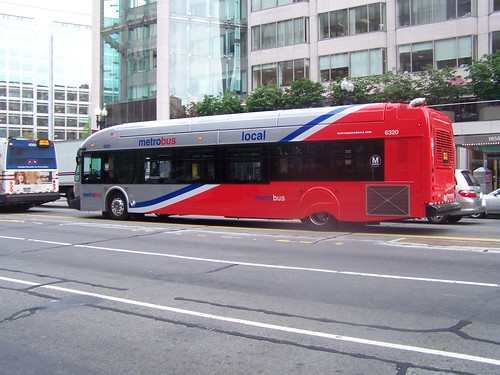 The Washington Post has an article ("Metro is mulling a major redesign of the bus system. But first, officials need to figure out why people aren't riding") about Metrobus and concerns about what should be done to right falling ridership.
The Washington Post has an article ("Metro is mulling a major redesign of the bus system. But first, officials need to figure out why people aren't riding") about Metrobus and concerns about what should be done to right falling ridership.A primary point in the article is that maybe the system should be completely redesigned a la fundamental reconfigurations in Houston.
Or Richmond, Virginia, which wasn't mentioned ("Richmond City Council signs off on bus system redesign," Richmond Times-Dispatch).
The Post article mentions but doesn't dwell on the fact that after one year, ridership in Houston was pretty much flat, up 1.2% ("A Year After Bus Redesign, METRO Houston Ridership is Up," Rice University).
The failure of the transit reconfiguration in Houston to produce a significant long term increase in ridership indicates that as much as the big transit network redesigns are touted, perhaps bigger changes may be needed.
This is similar to my point about the forthcoming Purple Line light rail system, which suggests that to best leverage the new transit line and investment, make complementary improvements across the transit network simultaneously.
FWIW, the Metrobus system is already mostly focused on high frequency service on major arterials, which is the root of bus network system changes in other cities like Houston.
But this high frequency network is focused on DC and some lines in Montgomery County and Virginia. Between DC and Maryland, many arterials lack cross-border bus service from the same transit line once they cross into Maryland, because Maryland doesn't prioritize the provision of continuous services, although research finds that every transfer between transit services results in a reduction of ridership.
DC area bus ridership compares favorably to other cities relative to population. But ridership is highest in DC except for certain suburban trunkline routes, which compare.
Personally, I believe that problems stem from the failure to do true transportation planning at the metropolitan scale.
WRT bus service, WMATA, rightly sees its priority as providing high ridership service on major arterials, supporting Metrorail service, and across jurisdictional lines (some suburban bus services cross jurisdictions, but it is comparatively rare).
-- Metropolitan Mass Transit Planning: Towards a Hierarchical and Conceptual Framework
What true metropolitan mass transit planning would do is set network depth, breadth, level of service, and level of quality requirements separately from transit operators. If they can't meet those requirements with the current budget and ridership, then more subsidies should be provided, rather than the constant cutting of service and routes.
Jurisdictions have gotten into the bus biz because through outsourcing, sometimes lack of unionization, and lower pay scales, they can deliver transit service more cheaply than WMATA.
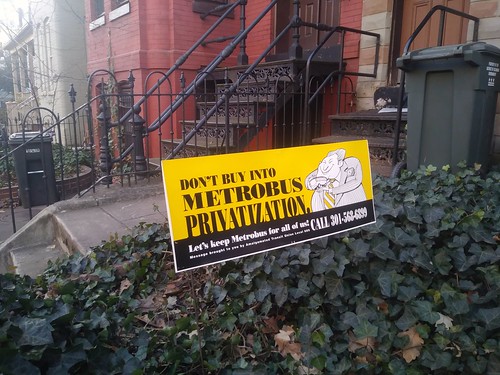
The local transit union is concerned about the potential of Metrobus (WMATA) privatization.
But as part of the transit system, bus service is complicated too. While Metrobus provides the majority of high capacity, cross-jurisdictional service, there are at least 12 other transit agencies providing bus service in the area, plus university shuttle services and other specialized services.
All the buses look different. So do the bus shelters, the signage, etc.
I have written about bus planning a lot, and I would say these are the most important points:
1. The impact of the sustainable mobility platform on use of mass transit services. The development of a more integrated set of mobility services in areas that are otherwise transit rich--even when the platform has to be integrated by the user--including biking, bike sharing, car sharing, ride hailing, delivery, and microtransit services, etc. is shifting some riders to alternatives, especially in the face of transit service degradation ("Is Uber Helping or Hurting Mass Transit?," New York Times; "Can LA mimic the success of Uber and Lyft by building an on-demand minibus system?," Los Angeles Times).
2. Is the pool of transit dependent riders shrinking? And in the face of this loss of ridership, given that bus service is relied upon by the transit dependent (people without cars), is this demographic group shrinking, in the areas where the Metrobus service pattern is dominant?
3. The DC area bus transit "network" is not perceived as a system/it is illegible. The balkanization of bus service across multiple agencies in the region makes it very hard for an average person to understand that bus service is a system and how it works. In other words, it isn't very legible.
However, note that the DC area transit agencies offer a regional transit pass, most use the SmarTrip card, and there is free transfer from one bus agency to another when using the SmarTrip card. The SmarTrip card also works on Baltimore-area transit.
For example, in the discussion cited in #4 below about improving "transit waiting environments" I make the point that bus shelters (and transit stations) are primary marketing touchpoints for transit generally and the bus system specifically, for people riding buses as well as those walking or driving by.
The condition of bus shelters, transit stations, lack of bus shelters or seating, and the level of information provided/not provided is an indicator of how the region values transit and bus service.
The jurisdictions don't think about this from the perspective of the "transit network" but only from their narrow perspective. As a result every city or county has different styled bus shelters, transit stations, and transit information, which can be very confusing to the rider. Each system has its own "call center" for information (although the online/app WMATA ride planner does integrate services).
Even within DC, there are different bus shelters on Metrorail station grounds and city streets (the latter under the control of DC), and the information presented within bus shelters is inconsistent--WMATA bus information is present in most shelters, but information for DC's Circulator bus system and/or neighborhood commercial districts is inconsistent. Transit information at bus stops is often out of date (although the bus tracker app works and all stops post the stop identification number.)
For example, somewhat incongruously, this bus shelter on Wisconsin Avenue NW at the Cathedral Commons development, miles from Downtown DC, has a Downtown DC information poster.
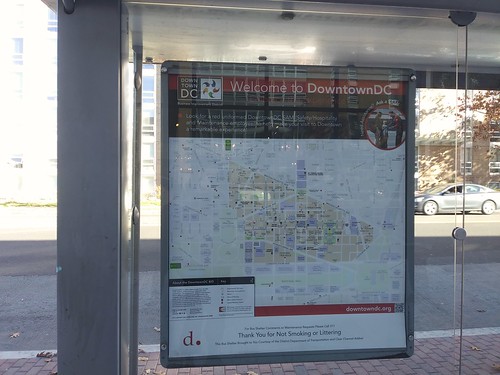
As Ivan Bennett, product design manager for bus service for Transport for London points out:
One reason other systems have failed is the lack of continuity. London bus stops extend beyond central areas and cover all routes in Greater London. Ivan indicated that passengers do not just want information about where they are travelling from, but when they get there, they need the same consistently presented information. People need information near their homes and local areas, not just in the centre of the city.Another example of dis-coordinated transit service, three different programs for bus rapid transit in Arlington-Fairfax; Montgomery County; and for Leesburg Pike ("Route 7 BRT proposal communicates the reality that the DC area doesn't adequately conduct transportation planning at the metropolitan-scale," 2016).
WMATA runs a service in Alexandria and Arlington called Metroway, as well as separately branded bus services called Rex on Richmond Highway/Route 1 and PikeRide on Columbia Pike. Montgomery County is planning its own BRT program. And there is a proposal for Route 7/Leesburg Pike, in Fairfax County and Alexandria, coordinated by the Northern Virginia Transportation Commission.
Each system has different branding, designs, different requirements for buses and transit shelters/stations, transit information, etc.
Instead, shouldn't there be one integrated system demarking bus rapid transit service across the metropolitan area?
4. Reposition bus service as a premium (design) product.
-- "Making bus service sexy and more equitable," (2007)
Mostly, bus service is seen as a social service, not a choice way to get around. My primary recommendation for repositioning bus service as attractive is to shift to double-deck buses, but within a use of the product design approach to completely reconceptualize the creation of an integrated bus transit system that is perceived as a desirable product and way to get around.
While this would make the service more attractive to choice riders, at the same time it would improve the service overall, making it a better value and product in terms of equity considerations.
We all think that "London buses" are cool--and these types of buses are used in many places besides London in Europe and Asia, and in limited ways in North America. Let's leverage that.
But the success of bus transit in London is more than the double deck bus.
The London Underground is an outlier for transit systems in that it has been a consistent innovator in design and usability for 100+ years. Key to this development was Frank Pick, who started at the agency being responsible for communications ("PR") and who laid the groundwork for corporate branding by coordinating all elements of the program into an integrated and extensive transit system -- advertising, branding, station architecture, vehicle design, and mapping -- with the highest standards for "design."
Today, that legacy is maintained through the creation of "product design managers" for the various transportation modes managed by the successor agency, Transport for London.
-- Product design guidelines, Transport for London
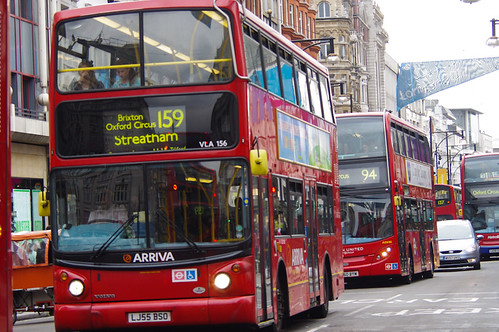
Buses Line up on Oxford Street, London. Photo by DJ Greer.
The piece goes on to lay out an integrated improvement agenda for bus service, proposed as a complement to the introduction of double deck buses
- Improve bus transit waiting environments
- Improve bus transit marketing
- Create a priority bus lane network in the core of the city
- Create a metropolitan scale Overnight bus network, including Night Owl bus service along subway lines during the hours that the subway service is closed
- Improve wayfinding and transit information
- Augment on-board bus announcements and information on schedules, signage, etc., with landmark and destination information
- Create "Mobility" stores as part of transportation demand management programming
- Incorporate neighborhood history information and public art elements into bus shelters
-- "Will buses ever be cool? Boston versus the Raleigh-Durham's GoTransit Model" (2017)
This piece discusses how the Raleigh-Durham area, while maintaining separate transit agencies, has integrated branding, fares, service schedules, design for the most part (one agency doesn't participate), types of buses used, and having one integrated customer service center for all the agencies.
Each agency in Raleigh-Durham has adopted GoTransit as their primary brand, with Go[agency] as the sub-brand. Each agency is assigned a different color, but otherwise the bus livery design is the same.
This is light years ahead of where the DC metropolitan area is in terms of offering an integrated bus service.
Although to be fair, WMATA was pushing some of these ideas 10+ years ago, based on my experience attending a regional bus conference convened by WMATA in 2006
As recommended in my Purple Line series, the area's bus transit program can be revamped, under a unified design, approach, and service system.
Like Triangle Transit, WMATA could lead the way to change, but that would require it to think as a transportation planning agency separate from its role as a transit operator. Therefore, ideally, the metropolitan transportation planning agency would take the lead and forge this change.
6. Make provision of dedicated bus transitways (and traffic signal prioritization for buses) a priority.
-- "Dedicated bus transitway on Georgia Avenue NW" (2016)
-- "It's been a drawn out process, but DC is in the process of creating transitways on 16th Street NW" (2017)
For bus service to compete with cars, it needs to be fast, even though a bus makes lots of stops. Having bus priority lanes during peak hour service is the way to better balance the needs of mass transit vs. individual motor vehicle users. Instead, for decades, motor vehicles have been prioritized over mass transit in terms of use of road space.
Making such changes will be controversial, but the focus in transportation planning needs to shift to optimality rather than automobile-centricity, given the real constraints on road capacity.
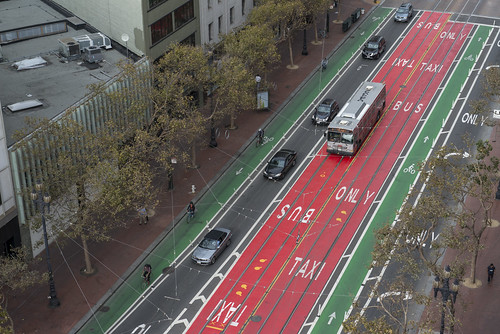
Bus and bicycle priority lanes on Market Street, San Francisco. SFMTA photo.

San Francisco Bay late night bus service transit map.
7. Create a overnight transit network at the metropolitan scale.
-- "Night and weekend transit/subway service" (2016)
-- "Overnight transit service: San Francisco" (2016)
-- "Night moves: the need for more night time (and weekend) transit service, especially when the subway is closed"" (2013)
The need for this has become particularly pronounced with various line closures for the Metrorail rehabilitation plan.
There are many examples that can be referenced, including San Francisco, Toronto, London, Hamburg, and Melbourne.
8. Don't forget bus services when creating HOT Lanes.
-- "So Your City Is Adding HOT Lanes. Will They Work for Transit?," Streetsblog, (2014)
When High Occupancy Toll Lanes are added, frequently bus service is touted during the planning phases, and isn't provided once the lanes become operational.
Granted, where HOT lanes are provided aren't necessarily the best place to provide transit service, but such services should be provided, not just promised, as part of multi-modal transportation planning.
9. Rearticulate long distance commuter bus services too. If we're going to rebrand and integrate "local" bus service, we may as well do this for long distance commuter bus service too.
Maryland has a somewhat integrated route network but not in the branding of buses as service is provided under multiple banners/liveries and information systems, and the system isn't good with bi-directional service (such as from DC to Annapolis).
Northern Virginia has separate long distance commuter bus services for each jurisdiction: Loudoun County; Prince William County; and Fredericksburg. The first two are provided by public agencies (Loudoun Transit, OmniRide), the latter service is provided by a for profit contractor. Each uses a different livery.
Perhaps like with how GO Transit in Ontario has both commuter bus and rail services and one common branding system, in line with my RACER concept for merging MARC and VRE ("One big idea: Getting MARC and Metrorail to integrate fares, stations, and marketing systems, using London Overground as an example"), the commuter bus network in Maryland and Virginia could be similarly rebranded as the RACER commuter bus network, and like with GoTransit in Raleigh-Durham, the rebranding could be launched in part with a common graphic design treatment across the now differentiated fleets of buses. (RACER stands for Railroad Authority of the Chesapeake Region.)
Bi-directional services should be added to certain routes.
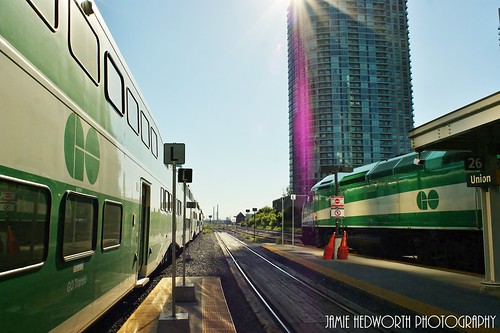
GO Train.
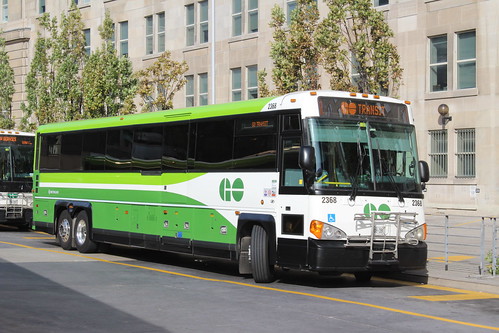
GO Bus.
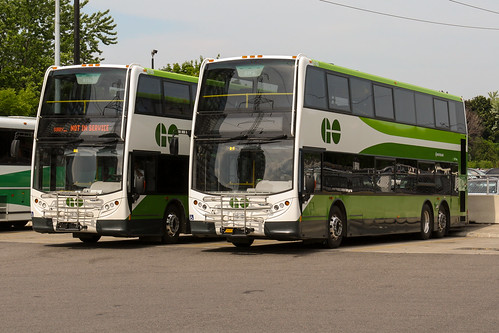
In any case, rebranding and repositioning commuter bus service as part of the Washington metropolitan and regional transit network is worth considering as part of an integrated transit network improvement program.
Labels: bus transit, busways/transitways, change-innovation-transformation, infrastructure, public realm framework, transit, transit marketing, transportation planning, urban design/placemaking




8 Comments:
If you want buses are a premium service and want to change the perception:
1) Put some shocks in the bus;
2) Don't use those new hybrid buses
3) charge more.
Functioning HVAC would also help.
Why doesn't MWCOG want to touch bus service?
in the intro I did fail to mention that the DC area bus fare is lower than most all US cities, with the exception of LA. However, systems with passes allow "linked trip" for bus + local rail for no additional fare, which is not how its done in the DC area.
Metrorail + bus is two fares with a slight discount.
It turns out that Maryland MTA (Baltimore area) fares are significantly lower than the DC area too (other than DC Circulator).
https://mta.maryland.gov/news/mta-fare-increase-june-25th
2. WRT the COG, in this case the Transportation Policy Board, I guess the real question is "why doesn't the COG want to have true metropolitan (and regional) scaled transportation planning via the TPB, which is the designated regional transportation planning entity by the US DOT?"
Bus is just one of the many elements of the failure of the DC area to have a national best practice example of an MPO (e.g., SF, Seattle, Philadelphia, Chicago, Minneapolis).
In SoCal the counties are so big, each is its own MPO, although they do work across borders with toll roads sometimes and commuter rail.
===
I bike mostly so I don't have the same experience I used to have with buses, e.g. shocks or HVAC. What're the new hybrid buses you're talking about? (the supercapacitor charging ones?)
I don't get the hybrid busses comment. I regularly take the ones DASH runs and the ride quality is very quiet and comfortable. Less herky jerky motion from the transmission, and quieter operation is appreciated both inside the vehicle and at the sidewalk level. RE: "shocks" there is only so much you can do to improve the ride of a heavy commercial vehicle when typical streets are in such poor condition.
RE: hybrid buses. Agreed improvement on the transmissions.
However, you’ll notice some problems.
1. A lot of the WMATA hybrids don’t seem to running properly; you’ll notice a much larger engine noise than it should have.
‘
2. Related., you’ll very common see the hybrids pushing out black smoke, which is a sign of a badly tuned engine. I’ll grant you I see that more of the hybrid circulators (even when they are almost brand new) than the WMATA buses but both are offenders.
3,. Again compare the hybrid WMATA buses vs the circulators and you’ll see the WMATA ones have better shocks — even if the Circulator bus is brand new. Cost cutting already.
I’ve noticed that DASH buses in general run much smoother than WAMTA buses.
I agree road surface is an issue but take the same route on a circulator
1. I noticed that the Circulator buses are promoting that they are new, with decals
https://www.flickr.com/photos/rllayman/39358881181
2. VIA in San Antonio has a bus shelter initiative. They've installed their 1,000th new shelter.
http://www.mysanantonio.com/opinion/editorials/article/VIA-gives-riders-some-much-needed-shelter-12460219.php
https://www.flickr.com/photos/rllayman/37641218425
https://www.dcpolicycenter.org/publications/improving-bus-service-east-anacostia-river
my first take, is of course the Federal City Council wouldn't ask me to write about this stuff...
(2) the point about fare pricing, the charging of two fares for rail and bus, I've made for years and years.
The issue is WMATA's fare policies focus on revenue generation and the conflict between the city and the suburbs over access vs. commuter service and limiting subsidy payments.
In my 2007 paper on transportation and land use I discussed the concept of making surface transit free in DC. It would cost maybe $70 million/year (I am remembering old stuff, this number might be off), and I think it'd be worth considering. Note that isn't what is recommended in the cited piece, but lower fares is. Again that comes down to the conflict between the city and the suburbs on the role of transit.
Although more recently I argued that making surface transit free isn't necessarily the priority, compared to improving system.
http://urbanplacesandspaces.blogspot.com/2016/12/is-making-surface-transit-free-best.html
And instead, DC should prioritize providing assistance to low income riders for discounted transit passes, as is done in other jurisdictions. But that money should come from local sources, not WMATA.
Sadly, I haven't treated equity/access as a priority issue for the transit system, the way I've written about just about everything else. E.g., this should be an element of the "transportation wish list" I write every so often.
===
Note that another issue missed is what I call the difference between a primary and tertiary bus network. Having intra-district bus services focused on getting people to the Metrorail stations is also something that should be considered, like how RideOn originally conceptualized their system.
Although it gets to the cost issue of the fare, which the DC Policy Center piece covers. But using the Tempe Orbit and other models, this intra-district bus would be free anyway, so that is less of an issue.
I do think the proposal of an infill blue line station at Minnesota and Benning Roadis interesting, one that hadn't occurred to me.
HOWEVER, I am pretty sure that the tracks don't go that way.
What I proposed in the creation of the separated Silver Line was a couple things that wouldn't necessary be focused east of the river.
Basically I get rid of the existing blue line in DC, and separate the orange line and the silver line. The orange line keeps the same configuration. But the Silver Line in DC parallels more easterly the orange line going to Union Station and H Street NE from Georgetown.
Then after adding a station at Oklahoma Avenue NE, it would cross the RFK lot underground and connect to the Stadium-Armory Station and pick back up the old Blue line routing east from that station.
The orange and silver lines would cross here so that people could transfer between them.
The Washington Post's January 1, 2018 article highlights concerns over falling Metrobus ridership, proposing a major redesign akin to Houston's. However, Houston's modest 1.2% ridership increase after a year questions the efficacy of such overhauls. To address declining ridership, simultaneous improvements, including Microtransit software solutions, and comprehensive network upgrades may be crucial for sustained success.
Post a Comment
<< Home